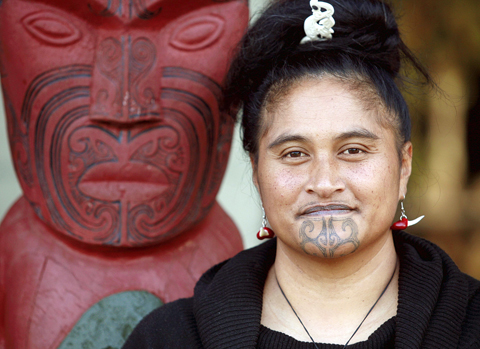The tattooists bent over Kingi Taurua for 15 hours, using chisels and a stick as a hammer to gouge bold Maori designs into his bloodied face, buttocks and legs.
“It started at 5 o’clock in the morning and it didn’t finish until 8 o’clock at night and so it was continuing all the time,” Taurua said. “They asked me if I wanted a break and I said no, because it was so painful, I thought if I stopped for a minute I won’t be able to go back and finish it.”
Taurua was following a long line of ancestors in receiving the tattoos, or moko as they are known to New Zealand’s indigenous Maori.

PHOTO: AFP
The art gradually died in the 19th and early 20th centuries as Maori culture was swamped and suppressed by a wave of European settlers.
But in the last 20 years, Maori culture and tattooing — ta moko — have experienced a strong revival and the distinctive dark swirls and designs once again can be seen on a growing number of Maori and on non-Maori as well.
All but a few now opt to have their moko done with modern tattoo machines rather than the painful and bloody traditional chisels or uhi and a range of colors are sometimes used as well as the traditional black.
The visibility of moko on some of New Zealand’s rugby All Blacks and international celebrities, such as English pop singer Robbie Williams, has helped spur a following internationally, especially in Europe.
The word tattoo comes from the Tahitian word tatau and the Maori brought the art form with them when they migrated to New Zealand from eastern Polynesia around 700 to 800 years ago, eventually establishing a distinctive local style.
Botanist Joseph Banks, who sailed with 18th century explorer James Cook on his first voyage of discovery to the Pacific, described “the immense elegance and justness” of the Maori moko, saying they were “finished with a masterly taste and execution.”
Facial moko on Maori men recognized high birth and rank, as well as achievements on the battlefield. Men and women of all ranks often had moko on their bodies and women had small tattoos carved on their chins, sometimes with blackened lips.
As Maori culture and society started to weaken with the growing flood of colonists, the tattooing of men’s faces ended in the mid-19th century, although the female or kauae moko continued to be done on some women into the 1920s.
A strong revival of Maori language and culture since the 1980s has also seen a resurgence of ta moko, reflecting a renewed pride in Maori identity.
Another influence was the 1994 New Zealand film Once Were Warriors, a story of domestic violence in a Maori family set against the backdrop of a working class Auckland suburb beset by gang violence.
Auckland-based moko artist Inia Taylor worked on the film before he took up tattooing, and he contributed to the design of the moko-type tattoos which adorned gang members and made a big impact on audiences.
“I didn’t know anyone who was involved in moko prior to that film,” Taylor said. “Afterwards, there was a lot of interest, people wanted to get tattooed. There was this massive hunger for it.”
Taurua said he was apprehensive about agreeing to a request by his fellow Ngapuhi tribe elders to get a moko in 2000 as a mark of respect for his position as an important elder.
“I was worried that people might see me as a member of a gang rather than a chief of a tribe,” he said. “Afterwards, I didn’t know whether to look up or look down when I passed people because I didn’t want to see the reaction on their faces, but now after all these years I am getting used to the fact.”
Most of the negative reactions come from European New Zealanders, many of whom still associate facial tattoos with gangs, he said.
Ta moko is a sensitive issue in more ways than the physical pain involved, with some Maori, including Taurua, arguing it should continue to be done only for traditional reasons.
“I believe once a moko goes on, it tells a story and it talks about the person wearing it, their genealogy, their ancestors — it’s a story,” he said.
“My question is, if you put a moko on somebody from overseas what story is on that moko?”

Philippine President Ferdinand Marcos Jr yesterday vowed that those behind bogus flood control projects would be arrested before Christmas, days after deadly back-to-back typhoons left swathes of the country underwater. Scores of construction firm owners, government officials and lawmakers — including Marcos’ cousin congressman — have been accused of pocketing funds for substandard or so-called “ghost” infrastructure projects. The Philippine Department of Finance has estimated the nation’s economy lost up to 118.5 billion pesos (US$2 billion) since 2023 due to corruption in flood control projects. Criminal cases against most of the people implicated are nearly complete, Marcos told reporters. “We don’t file cases for

Ecuadorans are today to vote on whether to allow the return of foreign military bases and the drafting of a new constitution that could give the country’s president more power. Voters are to decide on the presence of foreign military bases, which have been banned on Ecuadoran soil since 2008. A “yes” vote would likely bring the return of the US military to the Manta air base on the Pacific coast — once a hub for US anti-drug operations. Other questions concern ending public funding for political parties, reducing the number of lawmakers and creating an elected body that would

‘ATTACK ON CIVILIZATION’: The culture ministry released drawings of six missing statues representing the Roman goddess of Venus, the tallest of which was 40cm Investigators believe that the theft of several ancient statues dating back to the Roman era from Syria’s national museum was likely the work of an individual, not an organized gang, officials said on Wednesday. The National Museum of Damascus was closed after the heist was discovered early on Monday. The museum had reopened in January as the country recovers from a 14-year civil war and the fall of the 54-year al-Assad dynasty last year. On Wednesday, a security vehicle was parked outside the main gate of the museum in central Damascus while security guards stood nearby. People were not allowed in because

A feud has broken out between the top leaders of the far-right Alternative for Germany (AfD) party on whether to maintain close ties with Russia. The AfD leader Alice Weidel this week slammed planned visits to Russia by some party lawmakers, while coleader Tino Chrupalla voiced a defense of Russian President Vladimir Putin. The unusual split comes at a time when mainstream politicians have accused the anti-immigration AfD of acting as stooges for the Kremlin and even spying for Russia. The row has also erupted in a year in which the AfD is flying high, often polling above the record 20 percent it